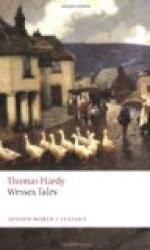She could get no further then for very exhaustion; and she went off in sudden collapse a few hours later, without having said anything more to her husband on the subject of her love for the poet. William Marchmill, in truth, like most husbands of several years’ standing, was little disturbed by retrospective jealousies, and had not shown the least anxiety to press her for confessions concerning a man dead and gone beyond any power of inconveniencing him more.
But when she had been buried a couple of years it chanced one day that, in turning over some forgotten papers that he wished to destroy before his second wife entered the house, he lighted on a lock of hair in an envelope, with the photograph of the deceased poet, a date being written on the back in his late wife’s hand. It was that of the time they spent at Solentsea.
Marchmill looked long and musingly at the hair and portrait, for something struck him. Fetching the little boy who had been the death of his mother, now a noisy toddler, he took him on his knee, held the lock of hair against the child’s head, and set up the photograph on the table behind, so that he could closely compare the features each countenance presented. There were undoubtedly strong traces of resemblance; the dreamy and peculiar expression of the poet’s face sat, as the transmitted idea, upon the child’s, and the hair was of the same hue.
‘I’m damned if I didn’t think so!’ murmured Marchmill. ’Then she did play me false with that fellow at the lodgings! Let me see: the dates—the second week in August . . . the third week in May . . . Yes . . . yes . . . Get away, you poor little brat! You are nothing to me!’
1893.
THE THREE STRANGERS
Among the few features of agricultural England which retain an appearance but little modified by the lapse of centuries, may be reckoned the high, grassy and furzy downs, coombs, or ewe-leases, as they are indifferently called, that fill a large area of certain counties in the south and south-west. If any mark of human occupation is met with hereon, it usually takes the form of the solitary cottage of some shepherd.
Fifty years ago such a lonely cottage stood on such a down, and may possibly be standing there now. In spite of its loneliness, however, the spot, by actual measurement, was not more than five miles from a county-town. Yet that affected it little. Five miles of irregular upland, during the long inimical seasons, with their sleets, snows, rains, and mists, afford withdrawing space enough to isolate a Timon or a Nebuchadnezzar; much less, in fair weather, to please that less repellent tribe, the poets, philosophers, artists, and others who ’conceive and meditate of pleasant things.’




